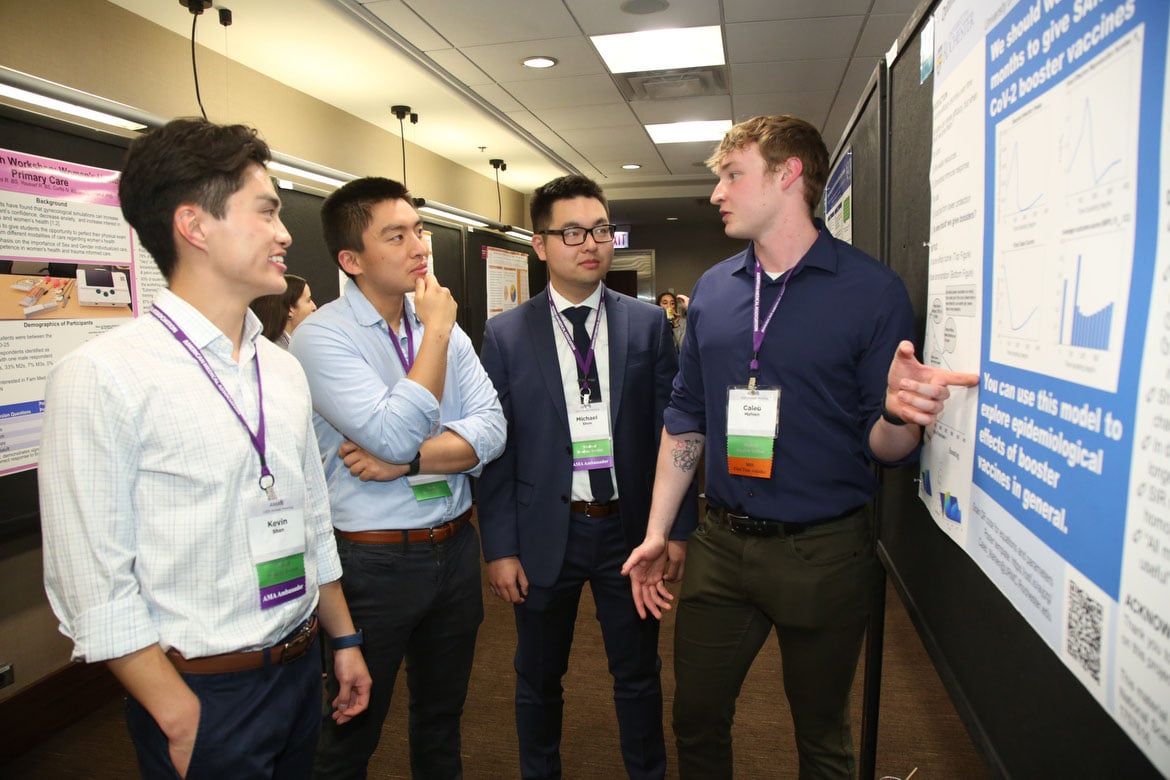Presenting your medical research poster is mostly science, but it’s also art.
That is one takeaway that medical students had after presenting their first posters during an AMA event that brought together medical student researchers to present their work across a wide array of topics.
For medical students looking to hone their research skills, the AMA offers resources and programs that bring you from the basics all the way to the AMA Research Challenge where you can compete for a $10,000 prize. The deadline to apply for the 2026 version of the event is July 16, 2026.
Tell a story
A research poster doesn’t need hard data to have an impact.
While volunteering at a shelter in Kalamazoo, Michigan, Ravi Trivedi, MD, noticed that children in the facility were often left without enrichment activities. To address that, Trivedi and a classmate created an after-school program at the facility aiming to educate students on basic science concepts, share foundational knowledge about how science and health are intertwined, and spark an interest in medicine. The program holds weekly sessions that draw parents and children.
“The reason we wanted to present this poster is because we wanted to reach out to other medical students and see if this is something they wanted to recreate in their communities,” said Dr. Trivedi, an AMA member and a third-year medical student at the time of his first poster presentation and now an internal medicine PGY-1. “We were able to set up this entire teaching program in a year.
So far we’ve seen really good progress with the kids really liking it and the parents at the shelters saying it’s really beneficial for their kids’ education.”
“We didn’t have as much hard data as a lot of other posters,” said Dr. Trivedi of his presentation at the 2023 AMA Poster Showcase. “What we did do is tell our story and put a road map out there of our experiences.”
Seek expert input
Years ago, The Ohio State University (OSU) College of Medicine Office of Global Health helped institute a neonatal resuscitation training program to reduce neonatal mortality in low-resourced settings such as Kenya. After sitting through a presentation on the program, Ellena Privitera asked a natural follow-up: How well did it work?
The poster presented by Privitera, a medical student from Ohio at the time of her first poster presentation, detailed retention of educators and health care workers who trained in the Helping Babies Breathe program. The findings indicated that most use the lessons learned on a frequent basis and share the teachings with colleagues.
Privitera is interested in global health, but as a first-time poster presenter she leaned on those who have demonstrated expertise in the field.
“I presented this to other global health researchers at Ohio State before doing this poster,” said Privitera who is currently a fourth-year medical student. “There was some data that I chose to omit because they questioned the validity of it or they thought it might not fit with what our research objectives were. That feedback really helped me decide what to put on this poster.”

Keep it simple
While your research may be very in the weeds, your poster should be accessible.
Now a pediatrics resident in Arizona, Leah Rotenbakh, MD, presented her first poster as a fourth-year medical student. Her project investigated radiation therapy tolerance in the treatment of breast cancer among carriers of the ataxia-telangiectasia mutant gene.
“The hardest part is taking this very complex topic and simplifying it. You want everybody to understand it, not just experts in a field.
“It’s very important to make your poster succinct and attention grabbing,” said Dr. Rotenbakh, an AMA member. “Now that I’m here looking around at all the other posters, I realize how little time you have to make an impression. Because of that, I probably would have used more graphics to convey data if I did my poster again."
Learn more from AMA Ed Hub™️ about designing and delivering impactful virtual research posters with this CME module.




